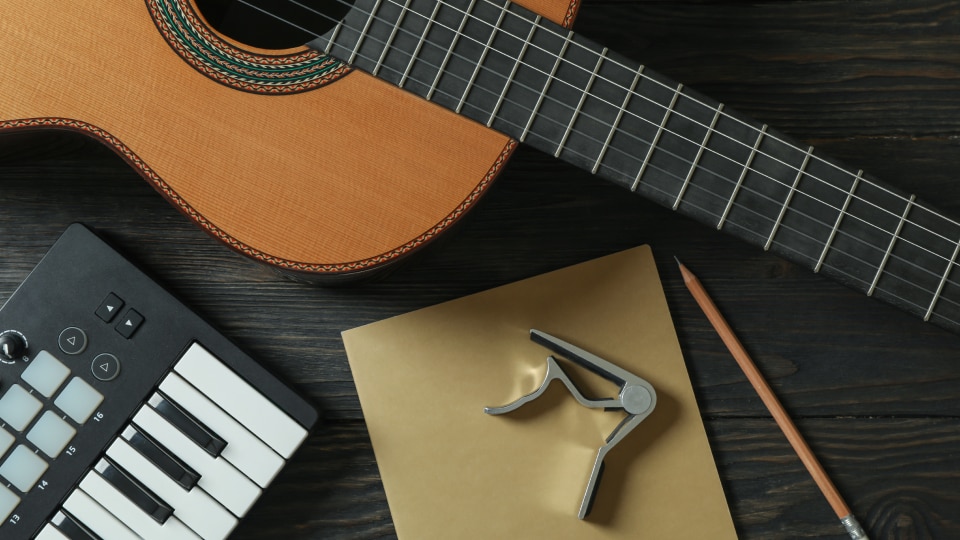When buying a new guitar, it’s often recommended that you pick up a capo — but what is a capo, and how do you use one?
Capos are fantastic tools for pros and beginners alike — they can remove the need for complex guitar chord shapes and help you play in different keys, all without the need to transpose your entire chord chart.
Here’s what you need to know about capo charts and why all guitarists should have a capo in their case.
What Is a Capo?
In its simplest form, a capo is a device that bars or holds a bar on a specific fret on either an acoustic guitar or an electric guitar. The capo placement acts as a new nut position on the guitar neck, altering the tuning of your guitar and allowing you to play new chords without actually making any physical changes.
There are three main styles of capo you’ll find on the market:
-
Trigger style
-
Yoke style
-
Strap style
The trigger-style capos are the most common. With a simple squeeze on the handle, the capo opens up, and you slide it to your desired position on the fretboard and release the squeeze to set it on the fret. These capos use spring tension to bite down on the string.
The common user error is adding side load to the string as you release, creating a bend; that being said, it’s easy to make sure the string surface is touching before releasing the handle slowly. When not using the capo, it’s easily detached and can be clipped to your music stand, tossed in your case, or clipped to the head of your guitar.
A yoke-style capo attaches completely around the neck of your guitar and is tightened by a singular screw on the back. This capo stays on your guitar and is usually left on the tuning peg side of your nut.
![[RS+] How To Use a Guitar Capo Chart SEO ARTICLE - a yoke-style capo](http://staticctf.ubisoft.com/J3yJr34U2pZ2Ieem48Dwy9uqj5PNUQTn/256m99w9hJ1pGXzSkboACc/c0ef0b6e8d887b961f3f3674713a64ae/A_yoke-style_capo.jpg)
When you want to use it, loosen it and slide it over the nut to the fret you would like to capo at, and tighten the handle on the back. Some guitar players prefer this capo because they feel it’s evenly tightened, while other players don’t like that this capo feels more permanent on the fretboard as it’s screwed down.
A strap-style capo is a historic capo, having a metal or wood rod paired with a strap that wraps around the neck of the guitar. These capos can be found with elastic, cotton, or other strap materials, and are generally inexpensive. They are known to wear out over time as the straps stretch, and frequently need to be replaced.
As you can see, a lot of choosing a capo comes to personal preference.
Why Should I Use a Capo?
![[RS+] How To Use a Guitar Capo Chart SEO ARTICLE - why should I use a capo](http://staticctf.ubisoft.com/J3yJr34U2pZ2Ieem48Dwy9uqj5PNUQTn/6kr9IGyqmqO11gQP6xO8m0/552e8dfd2775dcd9ecaaa1c1497848c1/Why_Should_I_Use_a_Capo.jpg)
The main reason guitar players use a capo is to change the tuning of the guitar without actually re-tuning it.
When you strum your guitar open without a capo, the notes played are E A D G B E, which is perfect if you’re playing D to E to G chords. This becomes more complex, however, when a song has chords such as F#, G#, and B.
This is why you capo. By sliding your capo to the 4th fret, E A D G B E becomes G# C# F# B D# G#.
At first glance, this might seem strange — what do you do with a tuning like that?
With a capo 4, to play an F# chord, you now play a D shape, to play a G#, you play an E shape, and to play a B chord, you play a G shape.
This can help you avoid difficult barre chords as you hone your skills, giving you the option to opt for simpler chord progressions and shapes.
To play these shapes, remember that the capo works as your guitar nut — the capo is your “fret zero.”
A D shape is usually played as 000232, with each number representing the fret each string is pressed on. This will now be played as 444676, with the capo being on fret number 4. Your chord shape is the exact same as an open D, but the chord being heard is an F#.
How To Read a Capo Chart
Understanding how capos work, let’s talk about how to read a capo chart.
When comparing the chart to a piece of music you would like to play, you’ll want to look for a row that has the open positions matching the notes you need to play. Compare this with the note positions at the top to match your comfort level.
Following the chart below, let’s capo at fret 2 — look down the left side of the chart until you find 2.
Looking along the row for fret 2, if you would like to play a B chord, slide right from the 2 until you see a B. Slide to the top of the map to see what basic chord shape you need to play.
To play a B chord with your capo on the second fret, you need to play the chord shape for A.
As another example, if you want to play a D major chord on capo 2, you’ll need to play a C-shape chord, and for a G major chord, you’ll need an F-shape chord. Click this image to see the full chart:
Try New Songs Using a Capo
Now that you know how to use a capo and read capo chord charts, it’s time to check out some new songs.
When learning to play guitar with Rocksmith+, you can use the filter options to practice songs that use capos. “Mountains” by Gabrielle Aplin, “Little Lion Man” by Mumford & Sons, and “Heart’s Content” by Brandi Carlile are just a few of the capo songs available in our library.
After you open the learning app on your computer, click the “SEARCH” icon at the top right to search the more than 6,000 available songs.
At this point, you can pick a specific genre you’d like to play, or hit “All Genres” for the complete library.
Once you choose a genre, click the “FILTERS” tab at the top right, where you can choose to filter songs that use capos.
There you go — you can now see all the available songs played with a capo, so strap on your guitar and have fun as you advance your guitar skills!
Sources:
Transpose | Music Copyright Infringement Resource
Balanced vs. Unbalanced Forces | The Physics Classroom
Physical Properties and characteristics of Fabrics - Textile School

![[RS+] How To Use a Guitar Capo Chart SEO ARTICLE - Capo Chart 1](http://staticctf.ubisoft.com/J3yJr34U2pZ2Ieem48Dwy9uqj5PNUQTn/5NdFYIlQceEijU6tqA3uu1/ca5092264966c52deb66a1f2d3a673ab/Capo_Chart_PNG.png)








